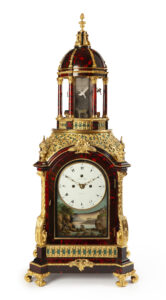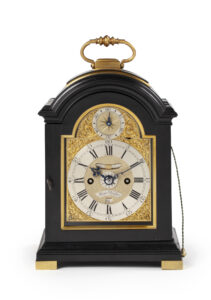BRACKET CLOCK Jn.o Brockbank London 483 Ca. 1775
M&R14
BRACKET CLOCK
Signed: Jn.o Brockbank London 483
Circa 1775
England
Movement
The eight-day, spring-driven double-fusee movement consists of going and striking trains with trip repeat. The going train has verge escapement and a short pendulum. The striking train indicates the hours fully on a bell. This can be repeated at all times by pulling a chord to the side of the clock. The backplate is profusely engraved with scroll motives. The movement is numbered in the top right corner: 483.
Dial
The arched brass dial has a silvered brass chapter ring with Roman hour numerals, Arabic five-minute and minute divisions. There is a date aperture in the matted centre above the VI. The time is indicated by a pair of pierced blued-steel hands. There is a subsidiary dials in the arch for switching off the striking: strike/silent. Under the XII is a recessed shaped silvered brass plaque bearing the maker’s signature and the number of the clock: Jn.o Brockbank London 483. The four corners are embellished by symmetrical cast-brass spandrels, as are the spaces next to the ring in the arch.
Case
The mahogany-veneered oak bell-top case has windows on all sides, the front door with brass-framed glass, so that the movement is entirely visible. The glass in the back door is also arched. In the top corners of the front door are pierced cast-brass sound frets. There are elaborately pierced silk-backed mahogany sound frets to the sides, whilst the corners are embellished by cast-brass caryatids. The clock is surmounted by four pineapple finials and a brass carrying handle on the top. Top and bottom of the case are moulded, whilst the clock rests on four brass bracket feet.
Duration 1 week
Height 54 cm
Width 28.5 cm
Depth: 19 cm
Literature
Brian Loomes, Watchmakers & Clockmakers of the World, London, 2006, p. 104.
The maker
John Brockbank started his apprenticeship in 1761 and became a member of the Clockmakers’ Company in 1769. He was established in London. In 1806 he began to work together with his brother under the name ‘Brockbanks’.
Note
Caryatids are figures which support buildings with their heads. They are sometimes also called Atlantes named after Atlas who carried the globe on his shoulders. The name ‘Caryatid’ is derived from the town of ‘Caryæ’ in the Peloponnesus or from the virgins who danced at feasts in the honour of the goddess Diana held in Caryæ.






